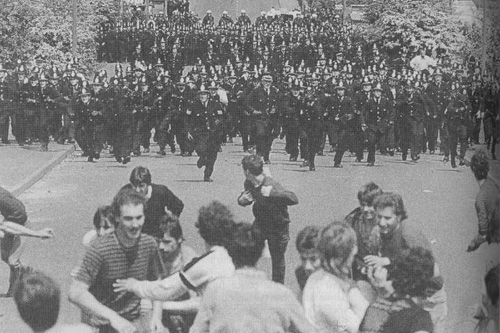
It is thirty years on from the beginning of the 1984-5 miners strike, and only now are the British public beginning to hear the truth about how the struggle was attacked by the ruling class. On 1 January 2014, almost 500 cabinet papers from 1984 were made public by the National Archives. Amongst these are the minutes of a secret meeting held on 15 September 1983 at 10 Downing Street. The Prime Minister Margaret Thatcher, Chancellor, Energy and Employment Secretaries,attended to discuss the National Coal Board’s (NCB) ongoing pit closure programme. These minutes, confirm what has long been understood by the striking miners and their supporters: that there was a carefully-planned strategy led by the Thatcher government and NCB to destroy the coal industry, eradicate militant workers organised in the National Union of Mineworkers (NUM), and in particular, to smash working class communities.
‘No record of this meeting should be circulated’
The minutes for the 15 September meeting are of crucial importance for understanding the history of the miners’ struggle. The immediate trigger was the 6 March 1984 announcement by NCB Chairman Ian MacGregor of a 4 million tonne cut in production, 20 pit closures and 20,000 redundancies within the year. These proposals built on more than a decade of ruling class attacks on mining communities which had already resulted in the closure of 115 pits, more than 100,000 redundancies and the creation of a division between low-paid miners in low-productivity pits of Kent, Scotland, Yorkshire and south Wales and high-paid miners in the high-productivity and high-investment pits of Nottinghamshire. The NUM, under the leadership of Arthur Scargill, opposed the plans, arguing that they intended to pave the way for the closure of around 70 pits and 85,000 redundancies, the majority among the poorer workers in low-productivity pits. Scargill’s claims were strenuously denied by the government and MacGregor, who wrote to every NUM member claiming that Scargill was deceiving them for political ends. Yet the minutes from 15 September 1983 back up Scargill’s version. The 1984 announcement was only the beginning, with MacGregor intending that ‘over the three years 1983-85 that a further 75 pits would be closed…the manpower at the end of that time in the industry would be down to 138,000 from its current level of 202,000’. The minutes close with the statement that ‘no record of this meeting should be circulated’. The intention of the government to conceal this knowledge is confirmed by another document issued a week later, insisting that there should be ‘nothing in writing which clarifies the understandings about strategy which exist between Mr MacGregor and the Secretary of State for Energy’. It was not Scargill but the NCB and Thatcher government who were deceiving workers for political ends.1
Thatcher commands her army
The newly-released documents also provide details of the strategies adopted by the British ruling class to combat the strike when it eventually took place. The government had been laying the groundwork for its response as early as 1981, when it began stockpiling coal to avoid any disruption that striking miners might cause. These reserves were a linchpin of state strategy, and Thatcher received daily updates on the quantities throughout the strike. Their importance is revealed by documents from July 1984 when, amidst dwindling stocks and dockworker strikes, the cabinet considered declaring a state of emergency and calling in the army to shift coal. At the time FRFI argued that ‘the length of this strike could have a critical impact on the miners strike’ – an observation confirmed by the decision to abandon this plan after the dockworker strike quickly
The documents also reveal how the government closely monitored the number of scab miners, reflecting the importance it placed on the back-to-work movement; personal meetings at 10 Downing Street with the families of scab miners are also detailed in the documents. FRFI detailed throughout the strike, how these tactics went hand in hand with the police batons of Orgreave as state weapons against striking miners.
The financial squeeze
Arthur Scargill argued on 3 March 1985, ‘the trade union movement in Britain, with a few notable exceptions, have left this union isolated’. Despite a concerted effort by the state to starve miners back to work – including slashing benefits on the pretence of an imaginary NUM ‘strike pay’ – and to financially cripple the NUM, the TUC refused to even impose so much as a 50p solidarity levy on its members. The passivity of the official trade union movement was contrasted by the solidarity of the poorer sections of the working class in Britain, Ireland and the socialist countries, who proved willing to provide both political and financial solidarity to the miners cause. In October 1984 miners in the Soviet Union donated more than $1.1m from their wages to the NUM. This was reported in MI5 briefing notes read by Thatcher on 1 November 1984, who sought to ‘consider urgently whether there is any way these developments could be prevented, whether by denunciation or otherwise’.
While Foreign Secretary Sir Geoffrey Howe demanded that the Soviet Embassy give a ‘clear account’ of the donation, Cabinet Secretary Sir Robert Armstrong explained that NUM members entering the country with money might be ‘stopped and searched at customs’.
The affair reveals the extent to which the state saw class solidarity as a major threat. Had the strikers been able to develop stronger and more consistent ties with the poorest sections of the working class in Britain, its outcome and the strength of the British working class movement, might have been entirely different.
Jack Edwards
1. See ‘Miners Strike: People Vs State’, David Reed and Olivia Adamson.?




